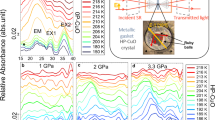Abstract
MAGNETIC circular dichroism (MCD) is the differential absorption of left and right circularly polarized light induced by a magnetic field1–4. By contrast with natural circular dichroism (CD), MCD is a property of all materials. Until now no instrumentation has been available for measuring CD and MCD in the near infrared (IR) spectral region with the high sensitivity routine in the visible and near ultraviolet. Some CD studies at wavelengths greater than 1 µm have been made on iron-sulphur proteins5,6. No MCD measurements have been made in this region. The recent development of photoelastic modulators (PEM)7 has made this possible and at the University of Southern California we have built a near IR CD and MCD instrument incorporating an ‘infrasil’ quartz PEM8. The instrument has a sensitivity of close to 10−5 absorbance units over its spectral range of 800–3,000 nm and employs magnetic fields up to 60 kgauss. We believe this will permit important new studies of metalloproteins and here report initial results on haemoproteins.
This is a preview of subscription content, access via your institution
Access options
Subscribe to this journal
Receive 51 print issues and online access
$199.00 per year
only $3.90 per issue
Buy this article
- Purchase on Springer Link
- Instant access to full article PDF
Prices may be subject to local taxes which are calculated during checkout
Similar content being viewed by others
References
Buckingham, A. D., and Stephens, P. J., Ann. Rev. Phys. Chem., 17, 399 (1966).
Schatz, P. N., and McCaffery, A. J., Quart. Rev. Chem. Soc., 23, 552 (1969).
Briat, B., and Djerassi, C., Nature, 217, 918 (1968).
Stephens, P. J., J. Chem. Phys., 52, 3489 (1970).
Eaton, W. A., and Lovenberg, W., J. Amer. Chem. Soc., 92, 7195 (1970).
Eaton, W. A., Palmer, G., Fee, J. A., Kimura, T., and Lovenberg, W., Proc. US Nat. Acad. Sci., 68, 3015 (1971).
Kemp, J. C., J. Opt. Soc. Amer., 59, 950 (1969).
Osborne, G. A., Cheng, J. C., and Stephens, P. J., Rev. Sci. Instrum. (in the press).
Eaton, W. A., and Charney, E., Probes of Structure and Function of Macromolecules and Membranes, 1, Probes and Membrane Function, 155 (Academic Press, New York, 1971).
Makinen, M. W., and Eaton, W. A., Ann. NY Acad. Sci. (in the press).
Smith, D. W., and Williams, R. J. P., Struct. Bond., 7, 1 (1970).
Perutz, M. F., Pulsinelli, P. D., and Ranney, H. M., Nature New Biology, 237, 259 (1972).
Perutz, M. F., Nature, 237, 495 (1972).
Offenhartz, P. O'D., J. Chem. Phys., 42, 3566 (1965).
Zerner, M., Gouterman, M., and Kobayashi, H., Theoret. Chim. Acta, 6, 363 (1966).
Shulman, R. G., Glarum, S. H., and Karplus, M., J. Mol. Biol., 57, 93 (1971).
Perutz, M. F., J. Crystal Growth, 2, 54 (1968).
Author information
Authors and Affiliations
Rights and permissions
About this article
Cite this article
CHENG, J., OSBORNE, G., STEPHENS, P. et al. Infrared Magnetic Circular Dichroism in the Study of Metalloproteins. Nature 241, 193–194 (1973). https://doi.org/10.1038/241193a0
Received:
Published:
Issue Date:
DOI: https://doi.org/10.1038/241193a0
This article is cited by
-
Philip J. Stephens: A scientific memoir
Theoretical Chemistry Accounts (2008)
-
Bis-methionine axial ligation of haem in bacterioferritin from Pseudomonas aeruginosa
Nature (1990)
-
Magnetic resonance Raman activity: Inverse Faraday effect in hemoglobin
Journal of Biological Physics (1986)
Comments
By submitting a comment you agree to abide by our Terms and Community Guidelines. If you find something abusive or that does not comply with our terms or guidelines please flag it as inappropriate.



